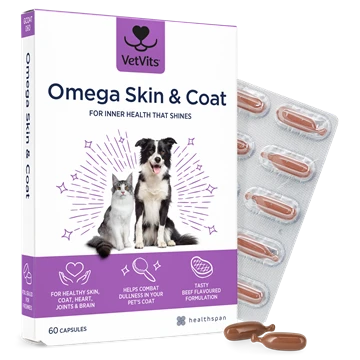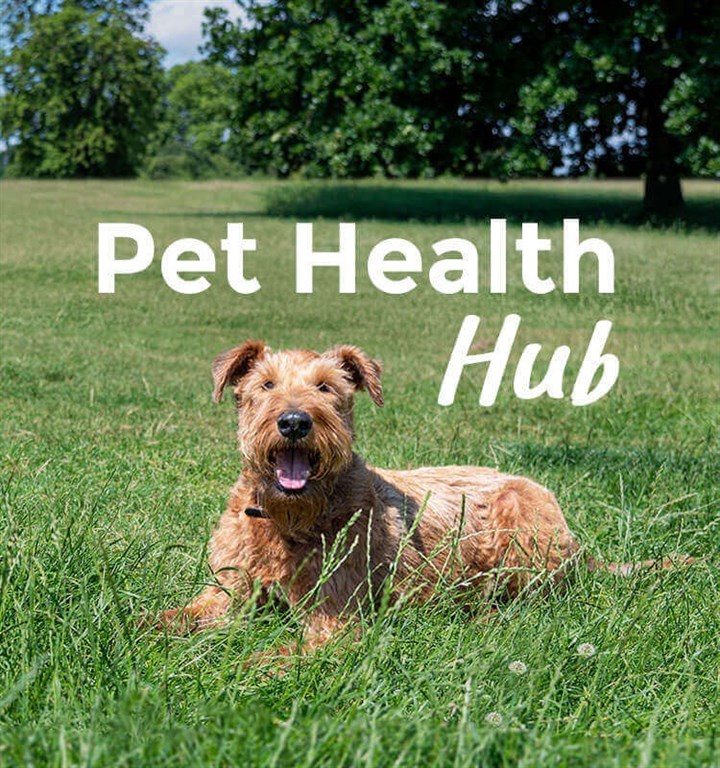The condition of your dog or cat’s coat offers a remarkable window into their overall wellbeing. More than just for stroking, their fur is one of the most visible indicators of internal health, and a change in its appearance, including dryness and dullness, is often the first sign that they may need extra support.
🕒 6 min read
This guide teaches you how to spot these signals, which is, of course, an essential part of proactive, everyday pet care.
How to Spot Common Skin and Coat Problems
Changes in your pet's coat can develop slowly over time, making them somewhat difficult to notice. However, detecting early signs becomes much simpler once you learn what to look for:
1. A Dull, Lacklustre Coat
A dull coat is one of the main warning signs of pet health problems. A healthy coat is glossy and smooth. Your dog's flat-looking fur or your cat's reduced grooming behaviour may indicate a health concern. The condition may stem from nutritional shortages, small-scale inflammation, and stress.
2. Dryness and Flakiness
The presence of white flakes on bedding materials and clothing after contact with your pet can be a clear indicator of dry skin problems. Your pet could also avoid contact due to the rough texture of its coat, which feels brittle. Dryness of this nature extends beyond visual appearance; it can increase the risk of developing cracks and itchy sensations, making the skin more susceptible to infections.
3. Persistent Itching and Scratching
It is challenging to observe and difficult to ignore when pets lick, bite, or chew excessively. Your pet's skin damage or inflammation exists when they persistently scratch or nibble at a single location. When pets engage in these behaviours, they develop bald spots and painful skin lesions, which could become open wounds when untreated.
4. Changes in Texture or Hair Loss
Coat quality becomes more important than appearance during this situation. Your dog's fur develops a wiry and puffy texture, but your cat experiences coat thinning as they age. The texture changes in their coats can point to hormonal imbalances, impaired nutrient absorption, and age-related conditions that need patient care.
Your first step should always be to visit your veterinarian. The veterinarian will examine your pet to identify any infections, parasites, or serious medical issues.
However, a key part of the solution can often be found in their diet. The skin needs omega-3 fatty acids to stay hydrated and control inflammation properly. Our omega skin and coat supplement offers a concentrated blend of these essential oils, working like an internal moisturiser to soothe and nourish your pet’s skin and fur from the inside out.
More Everyday Habits for a Healthy Pet Coat
Daily practices combined with nutritional excellence create the ultimate conditions for healthy coats. Great nutrition lays the foundation, but daily habits truly bring out the best in your pet’s skin and coat. Every day, you can support your pets through the following practical methods:
Regular Grooming
Pet brushing exists beyond its aesthetic purpose. The brushing process helps remove dead skin, loose fur, and debris while distributing natural oils, maintaining coat shine and smoothness. Brushing long-haired breeds regularly stops matting, which leads to painful skin irritation.
Thoughtful Bathing
The belief that bathing your dog regularly for itch relief leads people to wash their pets excessively, damaging their protective oils while worsening dryness. You should select pet-safe shampoo for bathing whenever necessary. Harsh chemical-based products and strong scents should be avoided when caring for sensitive skin, as they can worsen irritation.
Parasite Prevention
Pet skin issues commonly stem from flea infestations and mite and tick bites. A parasite prevention plan that receives veterinary approval must be consistently implemented. Did you know that indoor pets can still obtain parasites by walking outside, spending time in parks, or encountering other animals?
Keep Them Hydrated
Although water plays a crucial role in skin health, it is often underappreciated. Your pet should always have a clean and fresh water supply available. Skin health improves when it remains hydrated because it develops better resistance against environmental stress.
Connecting Coat Health to Joint Mobility
When you inspect your pet's coat for flakes or dullness, you should always check their movement patterns, too. Are they hesitant before jumping up? During their walks, do they show increased slowness while displaying reluctance to use stairs?
These minimal behavioural changes emerge as the first signs of joint needs. The ageing process and inflammation affect how your pet functions in life, just like they affect their skin health.
Look out for signs such as:
- The time it takes for your pet to stand up from rest has become longer.
- After napping or exercise, your pet shows stiff movement that affects their ability to move naturally.
- Your pet shows no interest in playing or performing physical activities.
- Your pet refuses to climb stairs and jump onto their usual places, such as the sofa.
These changes represent more than typical ageing signs. The physical indications signal that your pet experiences discomfort or joint pain.
A Targeted Approach to Support Skin and Joints
When it comes to caring for your pet, it helps to think holistically. Skin issues and joint stiffness often stem from similar internal processes, especially inflammation. That’s why supporting their whole system can be far more effective than just addressing isolated symptoms.
The combination of omega-3s represents an excellent base for promoting joint and skin health. Additional ingredients specifically addressing mobility problems become necessary when joint discomfort and strength rebuilding are significant concerns.
Our joint care supplement exists to provide pets with the needed support for comfortable and confident movement. It contains:
- Glucosamine and chondroitin work to preserve cartilage health while providing joint cushioning support.
- The natural marine ingredient green-lipped mussel contains anti-inflammatory compounds found in its structure.
- The joint fluid becomes thick and lubricating through hyaluronic acid, which enables smooth movement.
- MSM and vitamin C help the body repair tissue and reduce inflammation while supporting collagen production for better tissue repair.
These ingredients, used daily, can help reduce joint stiffness and improve mobility while maintaining joint health over time. They operate in parallel with omega-3s to maintain the health of skin, coat, and connective tissues.
Omega Skin & Coat
Shinier coat, healthier pet | Omega 3, 6 & 9 blend | Supports skin, coat, joints, brain and heart | Suitable for dogs and cats
- Blend of Omega 3, 6 & 9 for whole-body wellbeing
- Promotes healthy skin and a shiny, soft coat
- Supports joints, brain, and cardiovascular health
Healthy Coat, Happy Pet
By paying attention to your pet’s coat and the way they move, you’re not just being observant - you’re being proactive. You’re giving them the best chance at long-term comfort, mobility, and happiness.
Help your dog stay active and your cat feel their best with VetVit’s trusted dog supplements and cat supplements. Discover our full range of pet health products designed to support every stage of their life.

